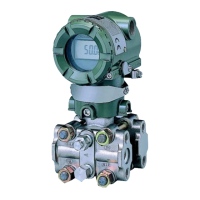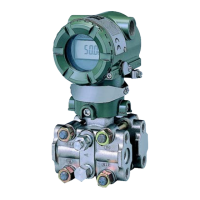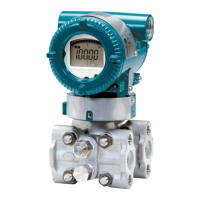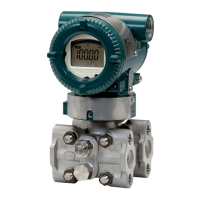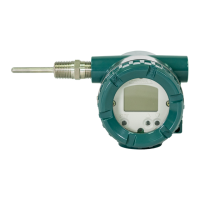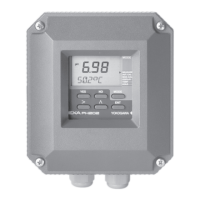IM 01C25T02-01E
5-2
5. CONFIGURATION
(LM device) with bus control function (Link Master
function) is allocated from a smaller address number
(20) side, and other devices (BASIC device) without
bus control function allocated from a larger address
number (247) side respectively. Place the EJX in the
range of the BASIC device. When the EJX is used as
Link Master, place the EJX in the range of the LM
device. Set the range of addresses to be used to the LM
device. Set the following parameters.
Table 5.1 Parameters for Setting Address Range
T0501.EPS
V (FUN) First-Unpolled-Node
Indicates the address next
to the address range used
for the host or other LM
device.
V (NUN) Number-of-
consecutive-
Unpolled-Node
Unused address range
Symbol
Parameters Description
The devices within the address range written as
“Unused” in Figure 5.1 cannot be used on a Fieldbus.
For other address ranges, the range is periodically
checked to identify when a new device is mounted.
Care must be taken to keep the unused device range as
narrow as possible so as to lessen the load on the
Fieldbus.
0xF7
0xF8
0xFB
0xFC
0xFF
V(FUN)
V(FUN)V(NUN)
LM device
Unused V(NUN)
BASIC device
Default address
Portable device address
F0501.EPS
Not used
0x00
0x0F
0x10
0x13
0x14
Bridge device
Figure 5.1 Available Range of Node Addresses
To ensure stable operation of Fieldbus, determine the
operation parameters and set them to the LM devices.
While the parameters in Table 5.2 are to be set, the
worst-case value of all the devices to be connected to
the same Fieldbus must be used. Refer to the specifica-
tion of each device for details. Table 5.2 lists EJX
specification values.
Table 5.2 Operation Parameter Values of the EJX to be
Set to LM Devices
Indicates the time
necessary for immediate
reply of the device. Unit of
time is in octets (256 µs).
Set maximum specification
for all devices. For EJX,
set a value of 4 or greater.
T0502.EPS
Symbol Parameters Description and Settings
V (ST) Slot-Time
V (MID) Minimum-Inter-PDU-
Delay
Minimum value of
communication data
intervals. Unit of time is in
octets (256 µs). Set the
maximum specification for
all devices. For EJX, set a
value of 4 or greater.
V (MRD) Maximum-Reply-Delay
The worst case time
elapsed until a reply is
recorded. The unit is Slot-
time; set the value so that
V (MRD) V (ST) is the
maximum value of the
specification for all
devices. For EJX, the
setting must be a value of
12 or greater.
5.3 Definition of Combining
Function Blocks
The input/output parameters for function blocks are
combined. As required, they can be combined with the
input of the control block. The setting is written to the
EJX link object. See “Block setting” in Section 5.6 for
the details. It is also possible to read values from the
host at proper intervals instead of connecting the EJX
block output to other blocks.
The combined blocks need to be executed synchro-
nously with other blocks on the communications
schedule. In this case, change the EJX schedule
according to the following table. The values in the
table are factory-settings.
Table 5.3 Execution Schedule of the EJX Function Blocks
T0503.EPS
Index Parameters
Setting (Enclosed is
factory-setting)
269
(SM)
MACROCYCLE_
DURATION
Cycle (MACROCYCLE)
period of control or
measurement. Unit is 1/32
ms. (16000 = 0.5 s)
276
(SM)
FB_START_ENTRY.1
AI1 block startup time.
Elapsed time from the start
of MACROCYCLE specified
in 1/32 ms. (0 = 0 s)
277 to
289
(SM)
FB_START_ENTRY.2
to
FB_START_ENTRY.14
Not used.

